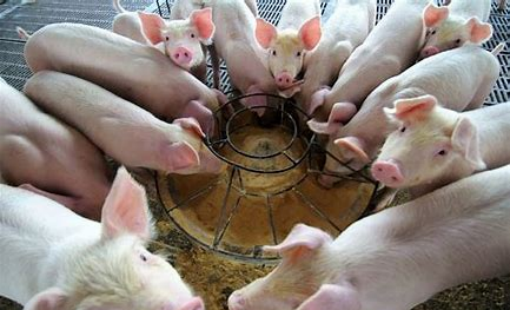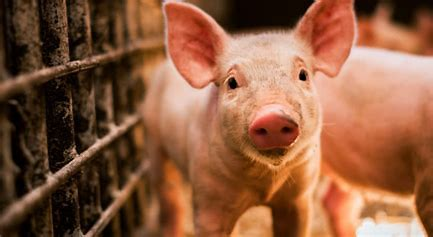
Release Date:2024.09.03
In recent years, pig breeding has been continuously transformed to the direction of standardization and intensification, and the market demand for high-quality pork products has been rising, which has greatly promoted the development of pig farming. In large-scale farms, pigs at different growth stages have different living characteristics, nutritional needs and feeding key points, and at the World Swine Industry Expo, experts shared the main points of feeding technology for pig herds at different stages.
The common feeding management mode in large-scale pig breeding
Follow the feeding method of "timing, quantity and quality"
Timing refers to the time and frequency of feeding pigs in different growth stages to be fixed. Timing feeding can train pigs to form regular rest, establish a good conditioned reflex, which is conducive to the secretion of digestive fluid in the stomach, thereby increasing gastrointestinal peristalsis and promoting the digestion and absorption of feed. For pigs in the fattening stage, timing feeding is particularly important.
Quantitative, refers to feeding different growth stages of the pig herd must master the amount, do not be sometimes more than sometimes, resulting in irregular pig diet, resulting in indigestion or diarrhea, reduce feed utilization.
Quality, refers to the different growth stages of pigs need nutrition is not the same, in the diet allocation to meet the nutritional standards of each stage of pigs, scientific arrangement of fine, crude, green and other different feed ratios, quality is not only conducive to improving the pig's feed intake and feed digestion and absorption capacity, but also to a certain extent to prevent the occurrence of pig gastrointestinal diseases.

Nutritional requirements and feeding techniques of pig herds at different stages
1.Nutritional requirements and feeding techniques of breeding boars
In order to make breeding boars have good reproductive performance, it is necessary to pay attention to the nutritional needs of breeding boars for energy, protein, vitamins and minerals. First of all, it is necessary to provide suitable energy for breeding boars. Insufficient energy supply will bring poor semen quality and slow development of sexual organs to breeding boars, but too much energy supply will also cause excessive weight and body condition of breeding boars, which is not conducive to reproductive performance.
2.Nutritional requirements of sows and feeding techniques
2.1A back-up sow
For the gilts who will have the task of mating, the short-term optimal feeding mode should be adopted 7 to 15 days before mating, that is, a certain proportion of concentrate should be added on the basis of the original feeding diet, and sufficient vitamin and mineral content should be ensured. By strengthening the nutrition of sows, the number of ovulation can be increased and the callowing rate can be improved.
2.2Pregnant sow
During the period from mating to 30 days of gestation, a high level of feeding will lead to an increase in the possibility of embryo death, so conventional feeding can be carried out according to the original feeding method and diet formulation, and the main purpose of this stage is to ensure the quality of feed. From 30 to 84 days of gestation, energy and protein supply should be strengthened for pigs with small body weight and lean body condition. From 85 to 114 days of gestation, concentrate should be appropriately increased, and concentrate should be controlled at about 2 kg per head per day.
2.3Lactating sow
The lactation period of sow is generally 30 ~ 42 days, but in the first 3 days after the sow just gave birth to the piglet, it is not suitable to feed too much, eating too much or too full is not conducive to the recovery of the uterus, should be fed less and add more frequently.
3.Nutritional requirements and feeding techniques of piglets
3.1Suckling piglets
It is appropriate to feed piglets at 7 days of age, and the feed must be clean and not fed moldy and spoiled feed. In daily management, the feed tank and sink used by piglets must be cleaned and disinfected; When feeding the diet, it is necessary to feed less and add more frequently to prevent uneven hunger and satiation of piglets; When changing feed, it is necessary to gradually transition, not suddenly change the type of feed, pay attention to observe the situation of piglet feces and urine, and find out the cause and treat the abnormality in time.
3.2Weaned piglets
The muscles and bones of piglets grow rapidly after weaning, and they need rich nutrition to meet their growth and development. And to do less feeding and add more frequently, timing quantitative, feeding 4 ~ 6 times a day, each time to 80% full is appropriate. In addition, the water supply should be sufficient, fresh, clean, and continuous throughout the day. In winter, the amount of drinking water should be 2 to 3 times of the daily feed intake, 4 times of the daily feed intake in spring and autumn, and 5 times of the daily feed intake in summer.

Summary
To sum up, through the analysis of the feeding mode design of pig groups in different stages of large-scale pig farms, it can be seen that the nutritional needs and feeding standards of different populations are different. Breeding farms should choose feeding modes that are suitable for their own development in a targeted and purposeful manner based on their actual production and local consumption and dietary habits, fundamentally achieving cost savings and efficiency improvement, and promoting the vigorous and stable development of breeding enterprises.
If you want to know more about the pig industry, please visit the World Swine Industry Expo website for more information.
Source:SWINE INDUSTRY SCIENCE
If there is any infringement, please contact to delete.